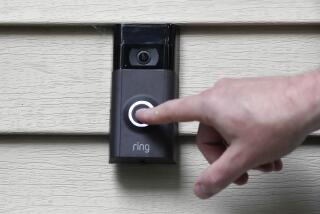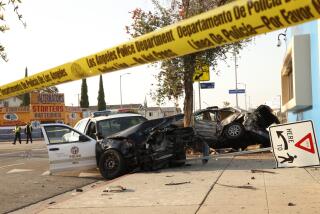THE GOODS : Nowadays, Car Security Comes as a Package Deal
When all the car alarms on your street blast, you know that the neighborhood has been hit either by a team of auto thieves or a sharp earthquake.
Car alarms have been notorious in the past for false alarms, but they are becoming increasingly sophisticated and attracting growing numbers of buyers.
An estimated 25% of U.S. households equip their cars with alarms, according to a survey conducted by the Electronic Industries Assn. Alarms come as standard equipment on 10 car models, and some manufacturers are also equipping cars with anti-theft electronic keys.
Still, about 4,400 cars are stolen every day in the United States, and fourteen of the top 20 insurance companies offer discounts on cars equipped with alarms, according to the association survey.
There are hundreds of alarm system manufacturers, but the top firms include Clifford Electronics, CodeAlarm, Directed Electronics, and Omega Research and Development, said Michele Guido, publisher of Installation News, an auto electronics trade magazine in Redondo Beach.
The conventional wisdom had been that auto alarms were easily defeated by professionals. But in newer systems, the alarm is just part of the anti-theft package.
The top systems include vibration sensors, impact sensors and radar-activated motion detectors, which are computer-controlled to distinguish between tampering and normal activity that occurs in parking lots, said Keith Field, marketing manager for Clifford Electronics in Chatsworth. A remote device is used to operate not only the alarm but also the car windows, the door locks and the trunk.
On the best systems the car’s ignition system or starter system is shut down until it is activated by the remote, so that even if a thief ignores the 125-decibel alarm the car cannot be readily started.
As the devices have become more sophisticated, the methods of thieves have improved as well. At one time, the remote devices operated on a few hundred codes, which thieves defeated with scanners that would broadcast all the known codes to deactivate a system on a target car.
The alarm industry responded with systems that had several billion possible codes. High-tech thieves then developed systems that could capture the specific security code on a target car. Now, the most sophisticated systems generate random codes each time they are used.
So why all those bleating alarms at 3 a.m.? The newer systems have more sophisticated sensors and better software, but there are plenty of older and less sophisticated systems still in use.
* Vartabedian cannot answer mail personally but will attempt to respond in this column to questions of general interest. Do not telephone. Write to Your Wheels, 1875 I St. N.W. #1100, Washington, D.C. 20006.







